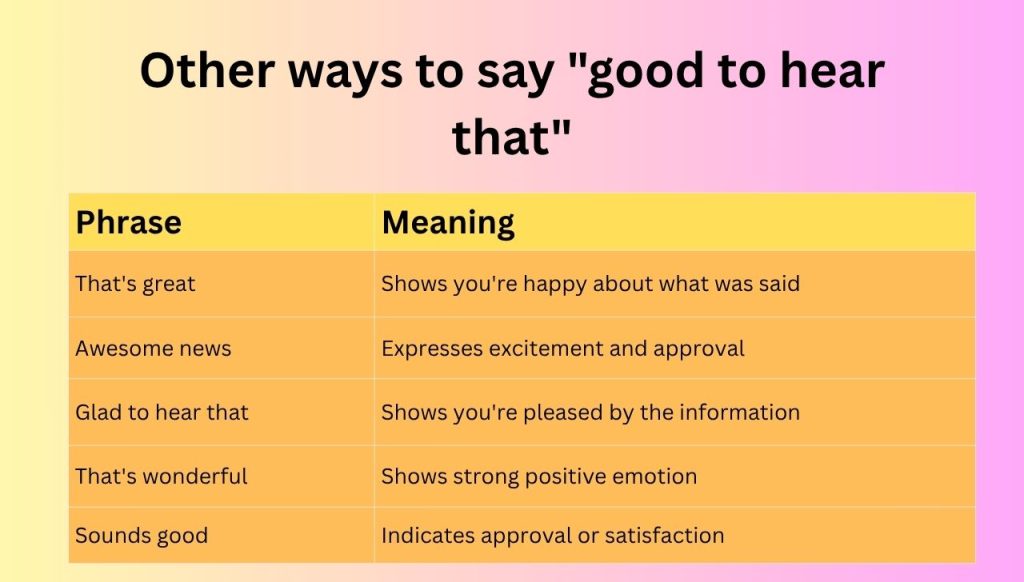Let’s be real—some phrases roll off the tongue so often they start sounding robotic. “Good to hear that” is one of those go-to expressions we toss into conversations, emails, and texts without thinking twice. It’s polite, positive, and… a little tired, if we’re honest. It’s like the verbal equivalent of a thumbs-up emoji—harmless, but not exactly thrilling.
So what if you want to say the same thing—acknowledge someone’s good news or respond warmly—without sounding like a copy-paste machine? Whether you’re chatting with coworkers, catching up with friends, or replying to a customer update, there are plenty of fresh, more personal ways to say it.
Before we jump into alternatives, let’s break down what this phrase means and why we use it in the first place. That way, the next time you want to mix it up, you’ll know exactly what tone you’re aiming for.
Dive Deeper : 30 Creative Alternatives to ‘Looking Forward to Seeing You’
“Good to Hear That” Meaning
On the surface, “good to hear that” is pretty straightforward. Someone shares something positive—maybe they recovered from an illness, aced a test, or finally solved that pesky issue at work—and you respond with this phrase to express your happiness for them. It’s simple to say, “I’m glad things worked out for you” without overcomplicating things.
But there’s a bit more nuance than we give it credit for. Depending on tone and context, it can mean:
- I’m genuinely happy for you.
- That’s a relief!
- Thanks for the update—I was curious.
- I care enough to acknowledge what you just shared.
It’s also neutral enough to work in professional or casual settings, which is probably why it’s so common. But that flexibility can also make it feel a little bland.
When to Use “Good to Hear That”
Timing and tone are everything. “Good to hear that” is best used when someone shares positive progress or good news, but not necessarily something wildly exciting. Think of scenarios like:
- “I finally got my internet fixed.”
- “Good to hear that!”
- “The client approved the proposal.”
- “Good to hear that!”
- “I’m feeling better now.”
- “Good to hear that!”
It works particularly well when you’re not trying to make a huge emotional statement—you just want to acknowledge something in a kind, low-key way.
It’s also a go-to phrase in emails, especially in professional contexts. You’re responding to a colleague who’s resolved an issue, wrapped up a task, or sent you a good report. In those cases, “Good to hear that” is the conversational glue—it keeps things polite, short, and functional.
But here’s the catch: it can sometimes sound a bit… automatic. If you use it too often or in the wrong setting, it might feel like a brush-off. Like you’re replying just to tick a box.
That’s why having a few alternative phrases in your pocket can help you come across as more engaged and thoughtful.
Why Say “Good to Hear That”
So why bother saying anything at all when someone gives you good news? Why not just move on to the next topic?
Because acknowledgment matters. Even the slightest bit of encouragement can make someone feel seen and heard. These small verbal signals build connection, especially in workplaces or digital conversations—where tone gets lost in translation.
“Good to hear that” plays a subtle but essential role in emotional reciprocity. When someone shares something personal or positive, even if it’s small, acknowledging it helps strengthen trust. It shows that you’re listening and care—even just a little.

Other ways to say “good to hear that”
| Phrase | Meaning |
|---|---|
| That’s great | Shows you’re happy about what was said |
| Awesome news | Expresses excitement and approval |
| Glad to hear that | Shows you’re pleased by the information |
| That’s wonderful | Shows strong positive emotion |
| Sounds good | Indicates approval or satisfaction |
| I’m happy for you | Expresses personal happiness for the other person |
| That’s fantastic | Expresses strong enthusiasm |
| Excellent | A brief, enthusiastic approval |
| That’s amazing | Shows you’re impressed or pleased |
| Good stuff | Casual way to show approval |
| Sweet! | Slang for great or excellent |
| That’s encouraging | Shows that you’re uplifted by the news |
| Well done | Complimenting someone’s achievement |
| That’s a relief | Used when something worrying turned out well |
| That’s lovely | Shows you find the news charming or nice |
| Great to know | Indicates you appreciate the information |
| Happy to hear it | Similar to “Glad to hear that” |
| That’s impressive | Shows you’re amazed or admire the outcome |
| Good going | Encouragement or approval for progress |
| Nice to hear | Simple, pleasant response |
| I’m pleased to hear that | Slightly more formal than “Glad to hear that” |
| That’s brilliant | British English for excellent news |
| That’s good news | Plain, direct approval |
| That’s reassuring | Indicates comfort or reduced worry |
| That’s heartening | Uplifting or hopeful news |
| I’m thrilled for you | Strong expression of happiness for someone |
| Great job | Compliment for something done well |
| That’s a good sign | Indicates positive progress or potential |
| That’s music to my ears | Idiom expressing joy in hearing something |
| Cheers to that | Informal, celebratory approval |
Dive Deeper : 30 Ways to Say “Please Note” Differently
Conclusion
Here’s the thing—language isn’t just about words; it’s about connection. “Good to hear that” is fine. It gets the job done. But it’s kind of like toast without butter: functional, but not memorable. Sprinkling in alternative phrases lets you show a little more personality, whether you’re replying to a colleague’s win, acknowledging a friend’s progress, or reacting to some happy update. You don’t need to reinvent the wheel—you just need to make it roll a little smoother.
So the next time someone gives you a piece of good news, resist the urge to autopilot your reply. You’ve got options now. Try a new phrase, maybe even throw in a little smile. Trust me—it won’t go unnoticed.

Grammar Nerd, ESL Trainer, Low-Key Comma Crusader
Daniel has taught English for over a decade, from small community classes in Oaxaca to bustling university halls in London. He has a knack for turning even the driest grammar points into relatable, real-life language tools—think fewer red pens, more real talk. He co-founded Grammation to make grammar less gatekeeper-y and more global. When he’s not decoding sentence structures, he’s probably hiking with a paperback novel or adding unnecessary hyphens for fun.
“The rules of grammar should empower people—not trip them up.”


